19-B. Walesville-Westmorland (New York), 1-2 juillet 1954, 1105-1127 LST. Météo : temps apparemment clair. Les signalements du 1er juillet 1954 arrivèrent au Dépot AF de Rome (New York), à propos d'un ovni ayant l'apparence d'un ballon. L'officier en charge dit croire qu'il s'agissait d'un ballon partiellement dégonflé, et que s'il était encore là le jour suivant, il déclencherait une enquête.
À 1968, 11:05 AM le 2 juillet 1954, le F-94C 51-13559 décolla pour une mission d'entraînement de routine. Le GCI demanda à l'appareil de change sa mission pour intercepter un appareil inconnu à 10 000 pieds. Le pilote identifia un appareil C-47 par son marquage de queue, et il lui fut alors demandé de vérifier un second appareil non-identifié qui se était à basse altitude et apparently letting down pour atterrir à la base aérienne de Griffith. Le rapport de la FA indique :
Alors que le pilote commençait une descente, il remarqua que le température du cockpit augmenta brusquement. L'augmentation de température amena le pilote à scruter les instruments. La lumière d'alarme incendie était allumée et le pilote informa l'observateur radar de ce fait. La lumière d'alarme incendie resta allumée après que les gaz aient été mis sur "ralenti" et donc moteur fut arrêté et l'équipage s'éjecta avec succès.
L'appareil s'écrasa à "l'Intersection de Walesville" et fut détruit. L'appareil toucha une maison et une automobile, blessant mortellement 4 personnes.
Le récit ci-dessus est tiré du rapport d'accident officiel de l'USAF ("Résumé des circonstances"). Il n'existe pas de dossier Blue Book parce qu'aucun ovni ne fut impliqué.
Conclusion :
- Le premier objet était probablement un ballon;
- Il n'y avait aucun ovni dans le cas de l'accident de l'appareil.
93-B. Wright-Patterson AFB, Ohio, August 1952, 1050-1113 LST. Weather: scattered clouds at 25,000 ft. This case, occurring almost over Project Blue Book's home base, is a very good example of confusion or contradictory evidence tending to obscure the true nature of a UFO incident.
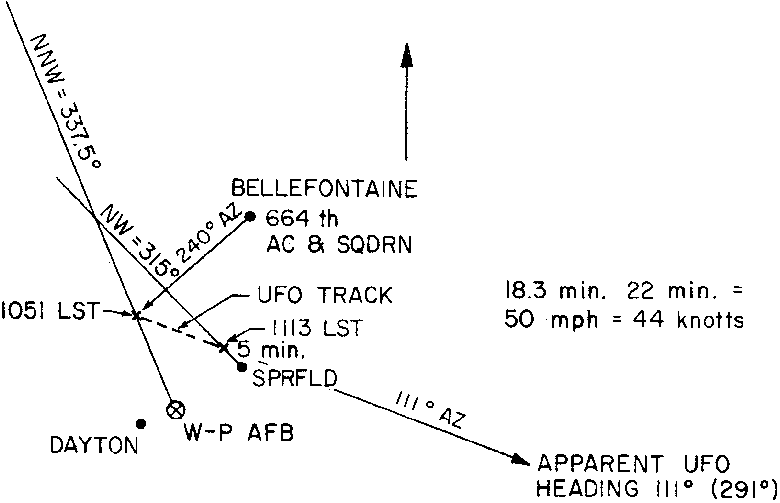
At 1051 LST an unidentified radar track appeared 20 mi. NNW of Wright Patterson AFB on the 664th AC&W
Squadron's GCI radar at Bellefontaine. The radar operator stated that the course was 240° at 400 knots. Elsewhere the
report states 450 knots; how he determined this is not made clear. Two F-86 aircraft from the 97th Fighter-Interceptor
Squadron, Wright-Patterson AFB, were vectored in and made visual contact at
1055 LST. Fighters stayed with the object until 1113 LST. The F-86s climbed to 48,000 ft., fell off, and made a second
climb. One aircraft had airborne radar activated and received a "weak" return. The object was described as "silver in
color, round in shape," and its altitude was estimated as 60,000-70,000 ft. The object appeared on the radar gunsight
film as a "fuzzy, small image ... with discernible motion ... that could be any darn thing
."
In this incident it is apparent that
- the UFO was a real object, and
- the visual and radar sightings (both ground and airborne) were of the same object.
All of the evidence points to a weather balloon except for the 400-450 knot speed, and the 240° flight path, which is against the prevailing upper winds. Known aircraft were ruled out because of the altitude. A U-2 would "fit," but the first one was not flown until 1955, and the visual appearance was all wrong. The radar returns eliminated astronomical objects, mirage was ruled out because of the high angles, and the sighting occurred "above the weather." The conclusion was: unknown.
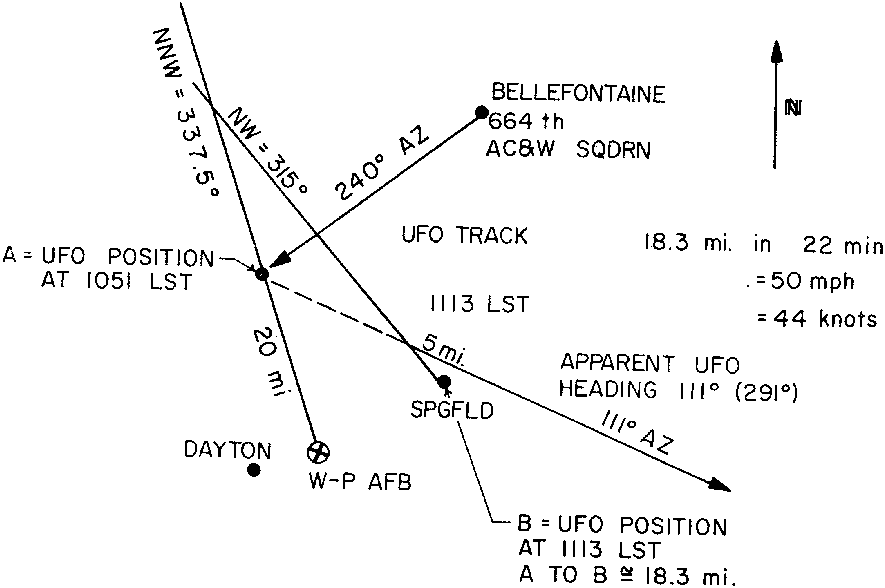
However, buried deep in the report was the radar operator's note that "At the time it was dropped (1113 LST)
object was five miles northwest of Springfield, Ohio
." This allows the UFO's course to be plotted on a map; Figs
18 and 19, shows such a map plot. It is readily apparent from this that the UFO's true heading was about 111° at an
average speed of only 44 knots. Apparently no one thought to make this simple check. Since the highest reported winds
from the radiosonde launched at Dayton at 1000 LST were 260°/31 knots at 50,000 ft. and 270°/33 knots at 55,000 ft.
the plotted track of the UFO is consistent with the observed upper winds. The blip was first "painted" at a 240°
azimuth, which may explain where that quantity originated in the UFO movement report.
Conclusion: almost certainly a weather balloon. Note that the winds reported for the Wright-Patterson AFB 1000 LST show winds blowing first from the east, then from the SSE, ultimately from the west at higher altitudes. These winds were blowing in such a manner that it is conceivable that Wright-Patterson's own radiosonde balloon may have been the UFO in this incident.
76-B. Near Charleston, W. Va., 4 May 1966, 0340 LST. Weather: Severe thunderstorms in area. Pilot of a Braniff Airlines Boeing 707 flying at 33,000 ft. observed on his left side what appeared to be a fast-flying aircraft with landing lights. Braniff's airborne radar recorded this unknown. Pilot requested the radar operator at Charleston sector of Indianapolis ARTC to look for traffic at his 8:30 or 9:00 position, and the radar picked up a track in this position. Return made a sweeping turn and disappeared off scope to the southwest.
An American Airlines pilot flying 20 mi. behind the Braniff plane saw the object. It appeared to him to be a normal aircraft with landing lights. This pilot stated he had often seen such aircraft with lights during AF refueling missions.
Estimated speed of the unknown was 750-800 mph. No unusual maneuvers were performed or any that were beyond known military aircraft capabilities at the time. AF explanation is that the unknown was an aircraft with landing lights on. This is consistent with the reported facts.
Cas 2. Lakenheath (Angleterre), 13-14 août 1956, 22 h 30-03 h 30 LST. Météo : globalement claire jusqu'à 0300 LST le 14 (pour les détails voir la section 4).
La probabilité qu'une propagation anormale de signaux radar puisse avoir été impliquée dans ce cas semble être faible. 1
ou 2 détails suggèrent une PA, en particulier la disparition rapportée de la première piste alors que l'ovni semblait
survoler le radar GCA de Bentwaters. A nouveau cela doit être soupesé avec la déclaration du contrôleur de Lakenheath
selon laquelle il y avait peu ou pas de traffic ou de cibles sur l'écran
, ce qui ne suggère pas du tout des
conditions de PA, et le comportement de la cible près de Lakenheath — apparemment continu et suivi sans difficulté. Le
"tailing" du chasseur de la RAF, à lui seul, semble indique la possibilité d'une image fantôme, mais ceci n'est
pas en accord avec le rapport selon lequel l'ovni arrêta de suivre le chasseur, alors que ce dernier retournait à sa
base, et partit dans une direction différente. Les opérateurs radar furent apparemment prudents pour calculer la vitesse de
l'ovni d'après les distances et heures estimées, et les vitesses furent rapportées comme étant cohérentes de course en
course, entre les épisodes stationnaires. Ce comportement serait relativement cohérent avec les réflexions depuis des
couches atmosphériques — mais pas dans tant de directions différentes.
Un mirage visuel à Bentwaters semble être hors de question en raison des observations combinées au sol et en l'air ; le pilote de C47 a apparemment vu l'ovni sous lui. Les objets visuels ne semblent pas avoir été des météores ; les déclarations d'observateurs selon lesquelles les météores étaient nombreux impliquent qu'ils étaient capables de différencier l'ovni de météores.
En résumé, il s'agit du cas plus intriguant et inhabituel des dossiers radar-visuels. Le comportement apparemment rationnel, intelligent de l'ovni suggère un appareillage mécanique d'origine inconnue comme l'explication la plus probable de cette observation. Cependant, au regard de la faillibilité inévitable des témoins, des explications plus conventionnelles de ce signalement ne peuvent être totalement exclues.
Kincheloe AFB, Sault Saint Marie, Michigan, 11-12 septembre 1967, 22 h 00-23 h 30 LST. Météo : claire, plafond illimité, visibilité illimitée (au-delà de 20 miles), pas d'orages dans cette région, vent de surface de 140°/4 noeuds, en haut de 240°-270°/15-35 noeuds. Le profil de réfractivité radio de Sault Saint Marie pour l'heure la plus applicable est montré en figure 21.
This is a good example of moving radar targets that cannot be seen visually, where there is a "forbidden cone" over the radar site. Some of the returns were even seen to approach within 5-15 mi. of the radar and disappear, apparently subsequently reappearing on the other side of the radar scope at about the same range that they disappeared. This sort of behavior is symptomatic of AP-echoes.
The meteorological data tend to confirm this interpretation. The refractivity profile shown in Fig. 21 displays three peculiarities: a strong subrefractive layer at the surface, a strong elevated duct at 325-520 m. (about 1100-1700 ft.) and a super-refractive layer at 1070-1360 m. (about 3500-4500 ft.). A ray-tracing is shown for this profile in Fig. 20. The ray shows noticeable changes in curvature as it passes through the different layers, an indication that strong partial reflections would be expected. With this profile, moving AP-echoes, produced in the manner described by Borden and Vickers (1953), could be expected to appear at apparent heights of between 2,000-3,000 ft. and 7,000-9,000 ft. No height information was supplied with this report, so the calculation above cannot be verified.
In summary, it appears that this is a case of observations of moving AP-echoes produced by unusually well stratified atmospheric conditions.
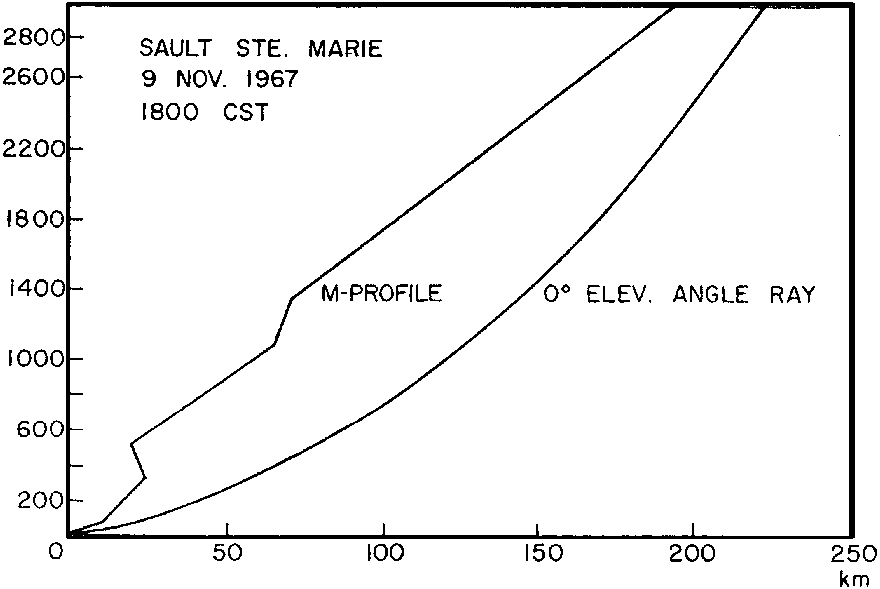
156-B. Gulf of Mexico, Coast Guard Cutter "Sebago," 25"47'N 89° 24'W, 5 November 1957, 0510-1537 LST. Météo : not given, but apparently some clouds in area. The most applicable radio refractivity data available are for Key West, Fla. 0600 and 1800 LST, 5 November 1957. They are shown in Figs. 22 and 23. One visual and three radar objects were included in this case. The ship's heading was 23° true. The first contact was a radar blip picked up at 0510 LST at 290° true azimuth, 14 miles. It moved south, approached the ship within 2 mi., and returned north along ship's port side. Contact was lost at 0514 LST. Average speed of this UFO was calculated as 250 mph. At 0516 LST a new blip was picked up at 188°, 22 mi.; this target departed at a computed 650 mph., disappearing at 0516 LST at 190°, 55 mi. The third radar target was acquired at 0520 LST at 350°, 7 mi.; it appeared to be stationary. While the third radar target was being watched on the scope, a visual object was observed for about 3 sec. at 0521 LST travelling from south to north at about 31° elevation between 270° and 310° azimuth. The third radar target remained stationary for about 1 min. and then slowly moved to the northeast, finally accelerating rapidly and moving off scope at 15°, 175 mi.
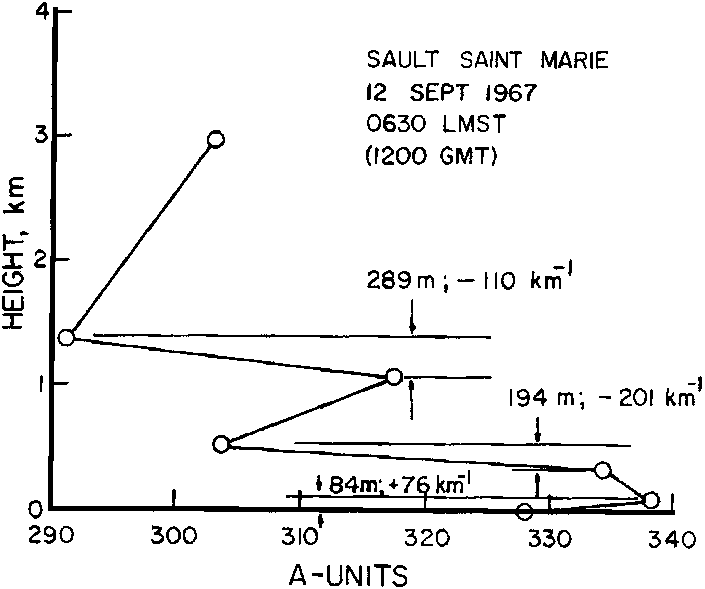
The visual object was described as "like a brilliant planet;" it was undoubtedly a meteor, and in any event obviously was unrelated to radar target number three, the only radar target visible at the same time.
The radar targets were, with the possible exception of the first one, erratic and unpredictable in their movements. The second and third radar blips appeared suddenly, well within the normal pick-up range of the ship's radar. These two blips were probably caused by anomalous propagation. The two Key West profiles, although taken at some distance from the ship's position, are indicative of rather unusual atmospheric conditions in the area. Indeed, the 1800 LST profile is probably one of the most unusual radio refractive index profiles that has ever been observed. The atmospheric structure was apparently one of alternating very wet and very dry layers. Patterns of this sort are often very stable in these subtropical latitudes, and tend to extend in rather homogeneous form over large horizontal distances. The ray-tracing of this profile, Fig. 23a, shows even greater changes in ray curvature. Strong partial reflections should be expected under these conditions.
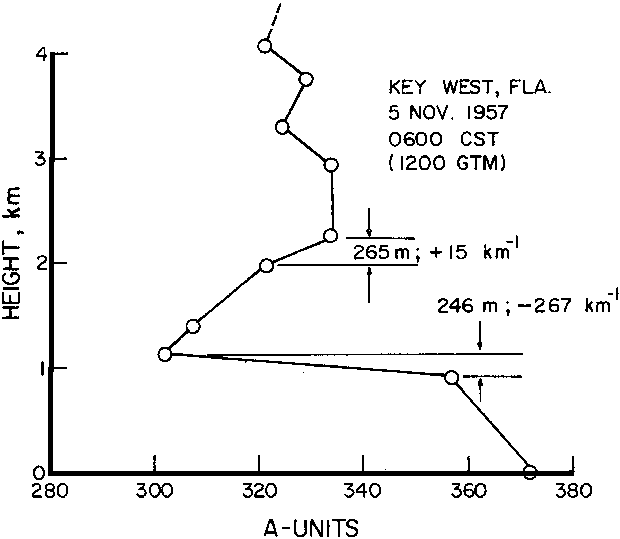
The first radar target behaved generally like an aircraft, and the AF investigators were of the opinion that it was an aircraft, probably from Eglin AFB to the north.
In summary, the weight of evidence points toward anomalous propagation as the cause of the radar echoes, the first possibly being an aircraft. The visual object was apparently a meteor.
Coincidentally, the ship, SS Hampton Roads, at 27° 50'N 91° 12'W sighted a round, glowing object high in the sky that faded as darkness approached at 1740-1750 LST. This object appeared to move with the upper winds. AF investigators concluded that it was in all probability a weather balloon.
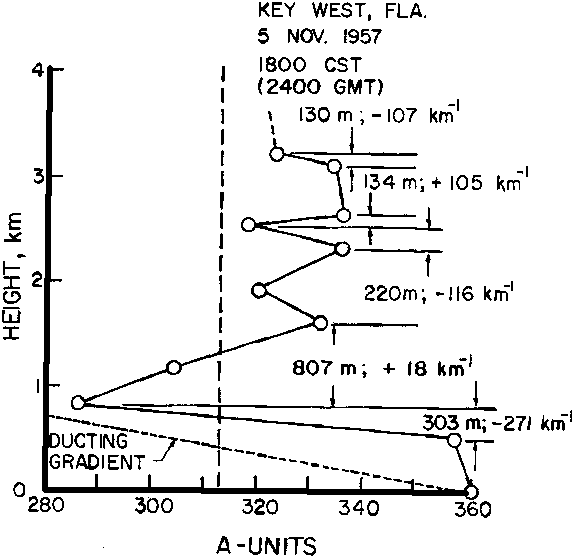
101-B. Canal Zone, 25 November 1952, 1806-2349 LST. Weather: generally clear, a few scattered clouds,
ceiling and visibility unlimited, visibility at 2,000 ft. was 50 mi. Radio refractivity profiles for Balboa, 1000 and
2200 LST 25 November 1952, are shown in Figs. 24 and 25. Two unidentified objects were tracked by gun-laying radar
during the period 1806-2349 LST. These objects, never present simultaneously, could have represented two tracks of the
same object. The radar returns were described as "firm and consistent
," and the objects were said to maneuver
in a "conventional manner
" at an average speed of 275 knots. Apparently the track speeds were as high as
720-960 mph. at times. Two B-26s, a B-17, and a PBM were scrambled but no radar or visual contact could be made with
the unknowns. The UFOs were not spotted from the ground, with the exception of a single report that an officer saw,
low in the sky, an "elongated yellow glow
" giving a soft light like a candle. It moved quickly, disappearing in
the west in about 3 sec. There were scattered clouds. It seems possible that this was the sighting of a meteor seen
through thin clouds producing the soft, yellow-glow effect. In any event, the description does not correspond with the
simultaneous radar track of the first UFO.
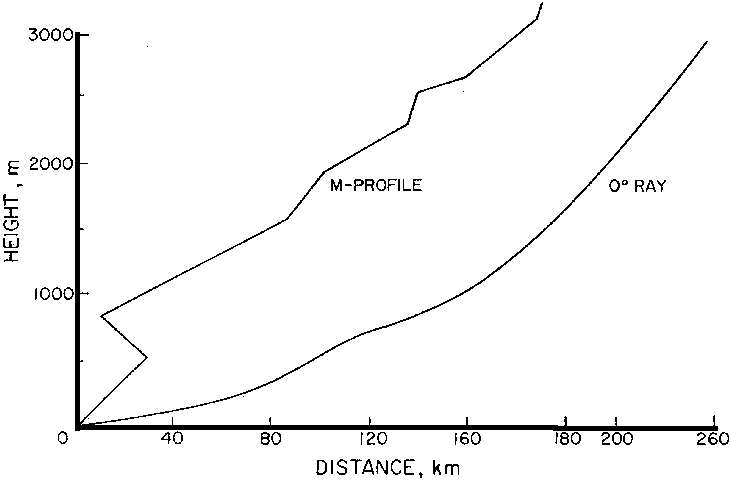
With visibility of 50 mi. it seems strange that the scrambled aircraft could not sight either of the UFOs. The Air Force report comments:
It is believed that due to radar units being slightly off calibration and due to delay in communication, interceptors did chase their own tail or were sent to intercept themselves.
It is also believed that the majority of the radar plots were legitimate unidentified objects.
The preparing officer knows of no object which flies at 275 knots, that could remain in the Canal Zone area for nearly six hours, maneuver from 1000 through 28,000 feet altitude, make no sound, and evade interception.
In fact, it is difficult to imagine any material object that could accomplish all these feats. The strange radar tracks were probably the product of anomalous propagation conditions, an hypothesis that would account for the facts above. The atmospheric conditions were certainly favorable for AP, as can be seen from the A-profiles in Figs 24 and 25. However, there are two considerations that argue against this hypothesis.
- The targets tracked behaved in a more rational, continuous manner, and covered a greater altitude range, than AP echoes of the type usually observed;
- If they were AP echoes, should these targets have appeared at not only 1806-2349 LST but around 1000 LST when the profile was obviously more favorable for AP than the 2200 LST profile?
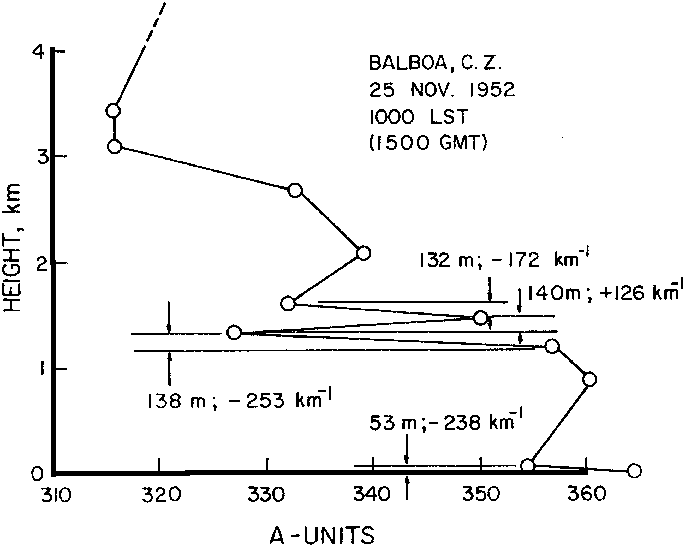
Despite these two contradictions to the AP hypothesis, the lack of any visual corroboration of the two UFOs makes any other hypothesis even more difficult to accept. This case therefore seems to fall, albeit inconclusively, into the classification of probable AP radar returns.
Cas 21. Colorado Springs, Colorado, 13 mai 1967, 15 h 40 LST (16 h 40 MDT). Météo : couvert, froid, averses éparses et averses de neige (graupel) dans le secteur, vents orientés nord d'environ 30 miles/h, rafales à 40 miles/h, visibilité air — plus de 15 miles (l'aéroport de Colorado Springs n'est pas limité par l'horizon ; des visibilités de 100 miles sont communément rapportées les jours clairs). Ceci est un cas uniquement radar, et est d'un intérêt particulier parce que l'ovni ne pouvait être vu, lorsqu'il y avait toute indication qu'il aurait dû être vu (voir section 4).
Du moment où l'ovni a été repéré pour la 1ʳᵉ fois au moment ou le vol Braniff a atterri sur la piste 35, la piste de l'ovni s'est comportée comme un écho fantôme, peut-être un retour du sol réfléchi depuis l'appareil. Ceci est indiqué par le fait que le blip de l'ovni apparût au double de la distance du blip de Braniff, et au même azimut, bien que l'angle d'élévation semble avoir été différent. Lorsque Braniff atterrit, cependant, la situation changea radicalement. Le blip de l'ovni tira vers la droite (l'est) et passa au-dessus de l'aéroport à une altitude indiquée d'environ 200 pieds. Comme indiqué par la FAA, ceci est précisément la procédure correcte pour un appareil en approche, ou un pratiquant une approche ILS mais n'ayant en fait pas l'intention d'atterrir. Bien que la trajectoire de l'ovni soit passée à moins de 1,5 mile de la tour de contrôle, et que le personnel présent ait été alerté de la situation, l'ovni n'était pas visible, même aux jumelles. Un vol de Continental Airlines, qui fut suivi 3 à 4 miles derrière l'ovni au 1er contact, et qui volait dans la même direction, ne le vit jamais non plus.
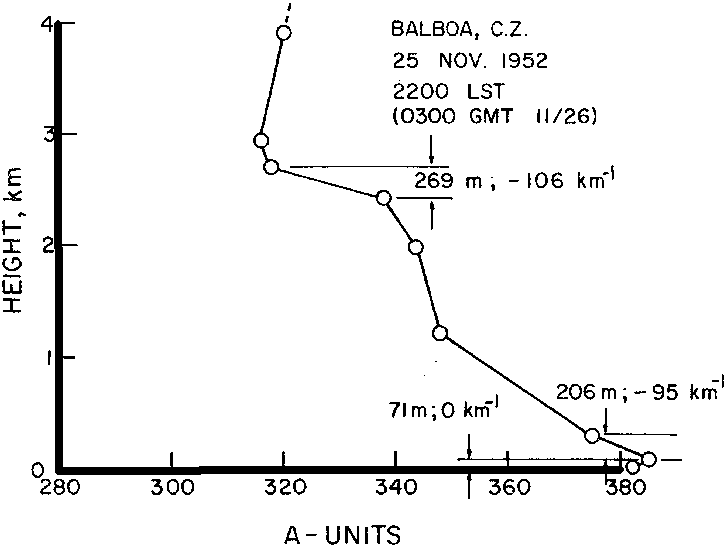
Les antennes transmettrices des radar PAR comme ASR sont situées à l'est de la piste 35, et elles sont à environ 1000 pieds éloignées de la ligne SO-NE. Un écho fantôme semble donc être exclu par au moins les considérations suivantes :
- Un écho fantôme, qu'il soit direct ou indirect, ne sera normalement pas indiqué à une hauteur de 200 pieds alors que le producteur de l'écho est au sol, comme c'était le cas ici ;
- Un fantôme direct est toujousr au même azimut que la cible en mouvement, et un écho indirect est au même azimut que le réflecteur fixe impliqué (voir Section 6, chapitre 5). Si un fantôme indirect avait été impliqué ici, l'écho fantôme serait donc toujours apparu bien à l'est du Braniff, pas au même azimut.
Les caractéristiques de vol au radar de l'ovni dans ce cas sont toutes compatibles avec l'hypothèse que l'inconnu était un jet de la série century (F100, F104, etc.), bien que rien n'ai jamais été vu ou entendu.
Ceci doit rester comme l'un des cas radar les plus intriguants connus, et aucune conclusion n'est possible à ce jour. Il semble inconcevable qu'un écho de propagation anormale se comporte de la manière décrite, en particulier concernant les changements d'altitude signalés, même si une PA était probable à ce moment. Au regard de la situation météorologique, il semblerait qu'une PA était plutôt improbable. A côté de cela, quelle est la probabilité qu'un retour de PA n'apparaisse qu'une seule fois, et à ce moment semble exécuter une parfaite approche d'entraînement ILS ?
Cas 35. Vandenberg AFB, Lompoc, Californie, 6-7 octobre 1967, 19 h 00-01 h 30 LST. Météo : clair, bonne visibilité, fortes inversions de température près de la surface causées par une advection of very warm (80°-90°F), dry air over the cool ocean surface (water temperature 58°-59°F). This sighting begins with an apparent mirage (of a ship probably 60 mi. beyond the normal horizon) and continues with a very large number of unknown targets that were found on tracking radars which were being used in a search mode (they normally are not used in this way). The project case file contains a good analysis of the probable nature of the radar targets, some of which were apparently birds and some apparently ships tracked at 80 mi. ranges as well as other AP-like returns that may have been associated with local intensification of the ducting layer. The nature of the visual objects is not as clear, although at least two of them appear to have been superior mirages of ships beyond the normal horizon. There were possibly some meteor sightings involved.
The meteorological conditions were quite interesting. The warm, dry air was apparently quite close to the water surface, at least in places. Data from Vandenberg and San Nicholas island indicate that in places the inversion was no thicker than about 90 m. (10 mb pressure difference). The contrast that may have existed can be calculated from these data:
| A ou près de la surface de la mer | A 90 m ou moins | |
|---|---|---|
| Pression | 1004 mb | 994 mb |
| Temperature °F | 58 °F | 90 °F |
| Temperature °C | 14 °C | 32 °C |
| Temperature °K | 287 °K | 305 °K |
| Optical N (5570A) | 275 (ppm) | 256 (ppm) |
The optical refractive index gradient that may have existed at the time was therefore on the order of -210 ppm. km-1, or a somewhat greater negative value, depending upon the thickness chosen for the layer. The value above is computed as (256-275) /0.090, based on the 90 m. maximum thickness assumed. Since the critical value of the gradient for a superior mirage is -157 ppm. km-1, it is quite apparent that the conditions required for the formation of extended superior mirages were most likely present on the date in question. The only problem with this explanation is the reported elevation angle of 10°, but as pointed out in the conclusions to this chapter such estimates by visual observers are invariably over-estimated by a large factor.
In summary, the conclusions arrived at by the investigators in this case seem to be adequately supported by the meteorological data available.
The sighting reported for 12 October 1967, 0025 LST, seems to be a classic example of the description of a scintillating, wandering star image seen through a strong inversion layer. Note particularly the estimated ratio of vertical and horizontal movements. Two very bright stars would have been close to the horizon at this time: Altair, magnitude 0.9, would have been at 277° azimuth and about 4° elevation angle; Vega, magnitude 0.1, would have been at about 313° azimuth and about 12° elevation angle. Of the two, Altair seems the more likely target because of the smaller elevation angle; the observers gave no estimate of either azimuth or elevation angle.
Synthèse des résultats
Une synthèse des résultats de cette investigation est donnée en tableau 1.
Le lecteur devrait noter que l'affectation de cas dans la catégorie de cause de PA probable pourrait avoir été faite sur la base du seul témoignage observationnel. C'est-à-dire, qu'il n'y avait aucun cas où les données météorologiques disponibles tendaient à nier l'hypothèse de propagation anormale, amenant ainsi le cas à être affecté à une autre catégorie. Par conséquent, un examen des données météorologiques disponibles pour les 19 cas de PA probable est en ordre.
-
Every one of the 19 cases is associated with clear or nearly clear weather. In 15 cases weather is described as "
clear and visibility unlimited
" (CAVU), in many of these "exceptional visibility
" is noted; in four cases the weather is "generally clear," with some scattered clouds, or a "high, thin broken" condition (usually meaning cirriform clouds). Such weather is indicative of stable atmospheric conditions that are favorable for the formation of layered, stratified refractive index profiles, i.e., they are conducive to anomalous propagation effects. The a priori probability of such a result, from a truly random sample of dates-times-places is roughly on the order of one chance in 200,000 (assuming that the probability of clear weather is roughly 0.5 in any single case).
| Classe | Explication la plus probable | Total classe | |||
|---|---|---|---|---|---|
| Propagation anormale | Appareillage de fabrication humaine | Inconnu | Pas ovni | ||
| I-A | 6 | 1 | 2 | 0 | 9 |
| I-B | 2 | 1 | 0 | 0 | 3 |
| I-C | 1 | 0 | 1 | 0 | 2 |
| I-D | 0 | 4 | 2 | 0 | 6 |
| Toute classe I | 9 | 6 | 5 | 0 | 19 |
| II-A | 6 | 0 | 0 | 0 | 6 |
| II-B | 4 | 2 | 2 | 1 | 9 |
| Toute classe II | 10 | 2 | 2 | 1 | 15 |
| Toutes classes | 19 | 8 | 7 | 1 | 35 |
- Of the 19 cases, all but two occur during the night. Although AP often occurs during the daytime, the nighttime hours are generally more favorable, and tend to greatly increase the a priori probability of encountering AP.
- In the 11 cases for which pertinent meteorological data are available, in every case the refractive index profile is favorable, to a greater or lesser degree, for the presence of anomalous propagation effects. The weakest case, the data for Silver Hill, 19 July 1952, (see p. 47), where inadequacies in the data were pointed out, has a near-super-refractive surface layer (gradient -81 ppm. km-1 and an elevated subrefractive layer. Of the remaining 11 profiles, seven showing ducting gradients (-157 ppm, km-1 or greater negative value) and four show super-refractive gradients (-100 to -157 ppm. km-1). Since the a priori probability of the occurrence of such profiles is on the order of 0.25 s1Bean, B. R., & E. J. Dutton. Radio Meteorology, National Bureau of Standards Monograph No. 92, U.S.G.P.0., (1966), the a priori probability of this result, given a truly random sample, is on the order of one in 106.
En synthèse globale de ces résultats, as they pertain to anomalous propagation of radio or optical waves, il semble que là où les données observationnelles ont désigné une propagation anormale comme étant la cause probable de l'incident ovni, les données météorologiques sont considérablement en faveur de la plausibilité de l'hypothèse de PA. Que ce résultat puisse avoir été que coincidental a été montré comme étant seulement de probabilité éloignée.
Conclusions et recommandations pour travail ultérieur
The following conclusions can be stated as a result of the investigation reported in this chapter:
- Anomalous Propagation (AP) effects are probably responsible for a large number of UFO reports in cases involving radar and visual sightings.
-
There are two common patterns that are evidenced in radar-visual cases involving anomalous propagation effects:
- Unusual AP radar targets are detected, and visual observers are instructed where to look for apparent UFOs and usually "find" them in the form of a star or other convenient object.
- Unusual optical effects cause visual observers to report UFOs and radar operators are directed where to look for them. As above, they usually "find" them, most often in the form of intermittent AP echoes, occasionally of the unusual moving variety.
- In radar-visual UFO sightings there is a pronounced tendency for observers to assume that radar and visual targets are correlated, often despite glaring discrepancies in the reported positions. There is a perhaps related tendency to accept radar information without checking it as carefully as the observer might normally do; hence errors are promulgated such as, direction of UFO movement confused with the azimuth at which it was observed on the radar scope, and UFO speed reported that is grossly at variance with plotted positions at times (both of these effects are well illustrated in Case 93-B).
- There is a general tendency among even experienced visual observers to grossly over-estimate small elevation angles. Minnaert (1954) states that the average "moon illusion" involves a factor of 2.5-3.5. The results of the present investigation imply that objects at elevation angles as small as 1° are estimated to be at angles larger than the true value by at least this factor or more. Interestingly, all of the elevation angles reported of visual objects in the cases examined in this chapter, not a single one is reported to be less than 10°. The fact that radar may subsequently "see" the UFOs at angles of only 1° to 4° seems not to bother the visual observers at all; in fact when the visual observers report apparent height-range, these values often turn out to be equivalent to elevation angles of only a degree or two. There seems to be a sort of "quantum effect" at work here, where an object must be either "on the horizon" (i.e., at 0° or at an elevation of greater than 10°.
- There are apparently some very unusual propagation effects, rarely encountered or reported, that occur under atmospheric conditions so rare that they may constitute unknown phenomena; if so, they deserve study. This seems to be the only conclusion one can reasonably reach from examination of some of the strangest cases (e.g., 190-N, 5 and 21).
- There is a small, but significant, residue of cases from the radar-visual files (i.e., 1482-N,Case 2) that have no plausible explanation as propagation phenomena and/or misinterpreted man-made objects.
A number of recommendations for future UFO investigative procedures are indicated by the results of this chapter:
- In any investigation of a UFO report, extremely careful efforts should be made to determine the correct azimuth and elevation angles of any visual or radar objects, by "post mortem" re-creation of sightings if necessary. This information is probably more useful in analysis of the case than the description of the objects or targets.
- Reported speeds and directions of UFOs, especially of radar UFOs, should be carefully checked (again, "post mortem" if necessary) and cross-checked for validity. This information is also often critical for subsequent analysis.
- Every effort should be made to get the most comprehensive and applicable meteorological data available for an UFO incident as quickly as possible. Many types of weather data are not retained permanently, and it is difficult or impossible to retrieve the appropriate data for a sighting months or years after the fact. Copies of original radiosonde recordings should be obtained for the closest sites, since these may be analyzed in more detail than that routinely practiced by weather bureaus for synoptic purposes. It should be emphasized that, for example, a nighttime profile is usually more germane to a nighttime sighting than is a daytime profile. For example, if an UFO incident occurs at 2100 or 2200 LST, an 0600 LST (next day) raob will generally be more pertinent to the propagation conditions involved than will an 1800 LST raob. The converse is also true.
-
Any field team investigating UFO reports and seeking to explore all radio/optical propagation aspects of the
sighting (a highly desirable goal), should be equipped with the following personnel as a minimum:
- An expert on the unusual aspects of electromagnetic wave propagation, at both radio and optical wave lengths;
- An expert in the interpretation and theory of radar targets, who is acquainted with all types of anomalous propagation and other spurious radar returns;
- An expert with wide experience in the physiology and psychology of human eyesight, and familiarity with optical illusory effects, etc.;
- A meteorologist, with specialized experience in micro-meteorology-climatology, mesoscale meteorology, and atmospheric physics.